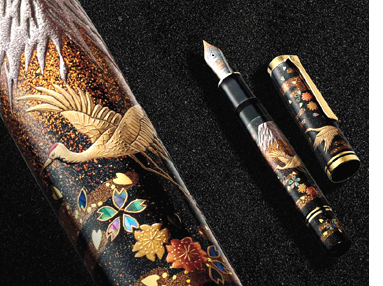Fountain pens, functionality, collecting and fashion.
 We all have in our memory the image of a hand writing with an ancient quill, dipping the tip of the quill into the ink from an inkwell that rests on the corner of a rickety desk and writing with great precision on thick paper in the light of a candle or the dim rays of light that enter through a window of a stone house while the other hand holds a piece of cloth to remove smudges. The hand may be that of a monk from the Middle Ages, of a child learning to write at the end of the 19th century, of a busy accountant, or of someone our mind has blurred.
We all have in our memory the image of a hand writing with an ancient quill, dipping the tip of the quill into the ink from an inkwell that rests on the corner of a rickety desk and writing with great precision on thick paper in the light of a candle or the dim rays of light that enter through a window of a stone house while the other hand holds a piece of cloth to remove smudges. The hand may be that of a monk from the Middle Ages, of a child learning to write at the end of the 19th century, of a busy accountant, or of someone our mind has blurred.
Fountain pens have changed a lot since this image. Fortunately, they continue to maintain their main functionality: writing, but adjectives have been attached to this functionality over the years, supported by innovation and technology. The nib feeder, the different loading systems (dropper, lever, vacuum, plunger, sack or bag, button and, later, cartridges and converters) or the simple cap, among others, are inventions that they have been nurturing the possibilities of fountain pens making them more practical, clean, reliable and transportable. The use of different materials in the manufacture of each of its parts has also favored the use of these writing instruments. The use of gold or steel, among other materials, in the nib, allow different degrees of flexibility or rigidity that permit different forms of writing; higher, lower or variable ink flow or different line thicknesses. The use of plastics, rubbers, metals, etc. the diversity of loading systems increases, there are different clip mechanisms, cap closures (thread, pressure, wedge, etc.), different techniques that prevent pressure changes and an endless number of small, or large, improvements that multiply the options offered by fountain pens from a functional point of view.
The mentioned attributes not only affect functionality, but also make fountain pens collector's items. Great collectors collect very diverse pieces in terms of loading systems, materials used, types of nib, colors, sizes, weights, year of manufacture, origin or country of manufacture, special, limited and numbered editions, techniques used in the creation, handmade or in series, and any other attribute that differentiates one fountain pen from another. Inkwells, pencil cases, pen holders and stationery are objects that complement, enrich, display and protect the collections.
The massive use of writing pens, whose growth was exponential since the end of the 19th century, together with the use of new materials and an infinity of colors and textures, has also made fountain pens a fashion accessory< /strong>, as well as a differentiating element. There are trends due to lifestyle, behaviors, habits or influenced by collective tastes that lead to a preference for a specific color or material. These trends can mark the preference for one fountain pen or another, but at the same time a fountain pen is acquired with the aim of differentiation, originality, exclusivity. Materials such as precious metals, wood, resins, lacquers, plastics, fiberglass, leather, etc. of infinite shades, combinations, textures, sizes, weights and shapes allow us to find pieces that adapt to the tastes and needs of each person, allowing us to hold fashion and differentiation in a single piece.
As a fashion accessory it is possible to find fountain pens that combine perfectly with all kinds of clothing, such as dresses, ties, scarves, shirts, suits, all kinds of footwear (shoes, boots, street sneakers, heels, etc.); also with accessories such as belts, bags, wallets, etc.; with jewelry such as rings - very close to the fountain pen - bracelets, necklaces, tie clips, brooches, etc. or even with nail polish or lipstick. There are countless possibilities and there is always a fountain pen that adapts to the one you choose, adding an elegant, differentiating, surprising touch and, of course, in keeping with your own style.
Likewise, the writing itself has its own style. Each person writes in their own way from the wording point of view, to the point that the same experience will never be accurately told by two different people. In the same way, there are no two identical calligraphies. Writing, especially handwriting, provides exclusivity, identity and personality, to the point of being dissected by critics, psychologists and graphologists. What remains in writing, moreover, it is not possible to unsay it, it is “in black on white”.
Taking into account the related points, at writing-pens.com we think that it is not only good to write by hand, if not always on many occasions, but preferably care must be taken with the exposed details and that what we write is done with style...
